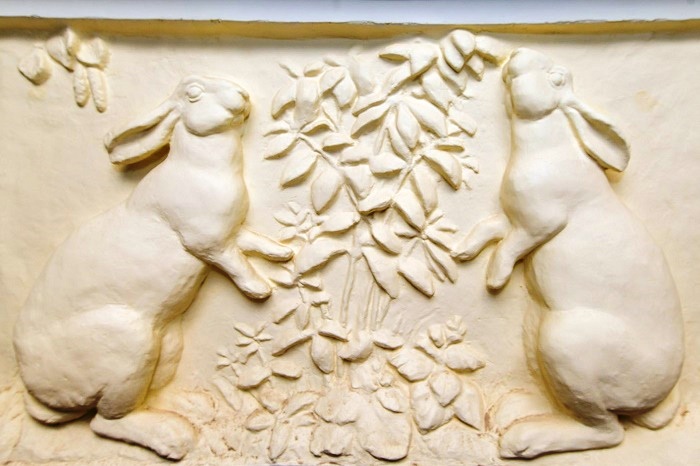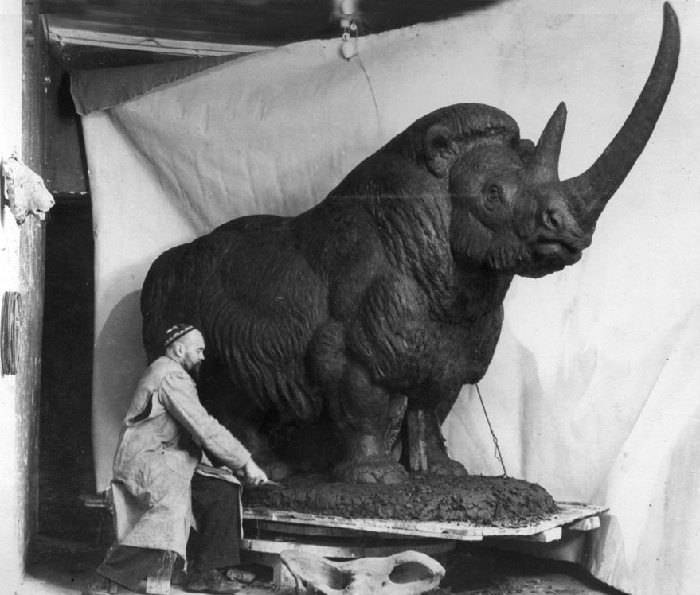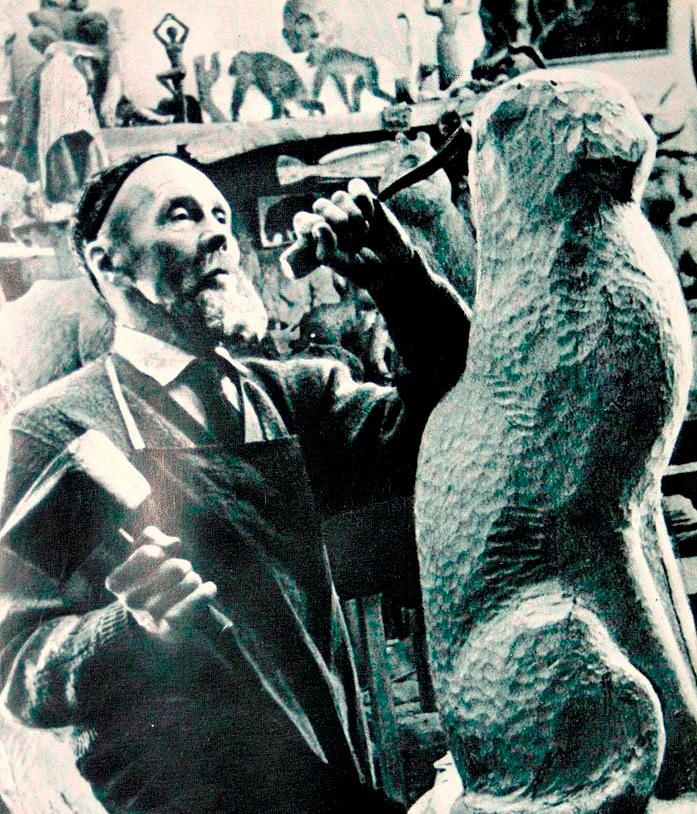Soviet sculptor Vasily Alekseevich Vatagin 1883-1969

Penguin with baby. 1960 Wood sculpture. The State Tretyakov Gallery, Moscow. Work by Soviet sculptor Vasily Alekseevich Vatagin (1883-1969)
Soviet sculptor Vasily Alekseevich Vatagin
Born in Moscow in 1883, Vasily Alekseevich Vatagin – Russian animal painter, sculptor and scientist-zoologist. The founder of the Darwin Museum, Alexander Fedorovich Kotts, was one of the first to draw attention to the talent of the young artist. Practically from the very foundation of the museum in 1907, the collaboration of the painter and sculptor V.A. Vatagin and director of the museum A. F. Kotts began. Vatagin, rightfully considered co-founder of the Darwin Museum has created more than 400 paintings, as well as about 100 sculptural works for 40 years of work.
Since childhood he was fond of drawing, and aged 15 he attended the studio of watercolor artist NA Martynov. In 1902, Vasily entered the natural department of the Physics and Mathematics Faculty of Moscow University. Also, he studied at the studio of the painter K. Yuon.
After graduating from the university, the artist made several trips to the zoological gardens of Western Europe, visited Central Asia, India, and northern Russia. There he performed a large number of sketches of animals and birds, which later became indispensable helpers in various works. Among them – zoological illustration, easel painting, book illustration and sculpture.
The collection of fine arts of the Darwin Museum began forming by Vatagin’s drawings of monkeys. The artist captured the experimental primates, followed by N. N. Ladygina-Kotts. A variety of appearance and coloring of monkeys, their pronounced “psychology” gave living material for both drawing and sculpture. Already in the very first “monkey” series, outlined the main features of the Vatagin talent. In particular, fixation of elusive, fleeting movements and understanding of animal mimicry. The funds of the Darwin Museum represent the palette of monkey emotions depicted in sketches from nature.
In addition, several series of paintings by Vatagin illustrate the theme of predators. One of these series, telling about the brown bear, represented by paintings made in 1932. About this series A. F. Kotts wrote: “Six paintings! The bear is the ruler of the northern taiga, who falls down the elk; a bear in oats and at the hollow for obtaining honey; it is on Kamchatka for fishing and in the Caucasus on a fruit tree. One and the same beast, but in different situations, in different poses, for different “deeds”. The author knew the model well, therefore in each of the plots he introduced the bear in close-up. Perhaps he did this as a sign of great respect for the animal, anciently revered in Russia. At the same time, the artist joined the portraits of this character with documentary details with an artistic vision.
Particularly successful were Watagin’s images of wild cats. On his canvases he captured the plasticity of proud tigers, the reign of lions, the slenderness of leopards, the elegance and secrecy of cougars. The created series is a picturesque narrative about the diversity of these graceful predators. Being a zoologist, Vatagin was always exceptionally accurate, but he also cared about the fact that the animal form fit organically into the surrounding environment.
The artist wrote about this: “The successfully found composition and colorful attitude of the animal to the landscape is one of the conditions of animalistic painting. If these relations violated in one direction or another, the picture can be a “landscape with a figure” or approach a zoological illustration.” V.A. Vatagin coped admirably with the task of depicting an animal in nature. And his animals live in pictures – they grow offspring, hunt, rest. The artist devoted all his life to them.
Meanwhile, the artist traveled a lot around his native country and around the world. And the result was hundreds of drawings made in a wide variety of techniques – pencil, watercolor, ink, lithography, and gouache. In addition, a lot of beautiful sculptures. Besides, he illustrated a large number of books. Among them works by R. Kipling, D. London, L. Tolstoy, E. Seton-Thompson, and others.
The artist’s works are in the expositions of many museums, including the Tretyakov Gallery and the Russian Museum. However, the largest collection of animal paintings, drawings and sculptures of the artist are in the State Darwin Museum. And it was Vatagin who carried out several models for the Leningrad Porcelain Factory of M.V. Lomonosov. Of course, Vatagin had very talented students who continued his work.
Soviet sculptor Vasily Alekseevich Vatagin

A kangaroo

A lioness

A tiger, drawing

A wolf

A woman with rabbits

Adventures of Mowgli

An elephant sculpture

Andrei Rublev. 1918-1919. Gypsum. Not saved

Bas-relief on the central facade of the building of the pavilion Rabbit breeding at VDNKh, Moscow

Bears hunting for fish

Cat’s sculpture

Falcon. 1946. The author of the form – VA. Vatagin. Leningrad Porcelain Factory

Giraffes

Hawk

Himalayan bear. Wooden sculpture. 1925

Hippo family

Moscow Zoo. Book Illustration. Bears

Mowgli and wolf

Peacock

Rabbits, Bas-relief sculpture

Vatagin working on a giant sculpture

Sculpture of Gibbon. 1956. The author of the form – V.A. Vatagin

Sketch of black crow

Soviet sculptor Vasily Alekseevich Vatagin (1883-1969)

The book by V.A. Vatagin

The project of the monument to Andrei Rublev. 1918

The work of the sculptor V.A. Vatagin. Andrei Rublev. 1918-1919. Gypsum, toning. From the collection of the State Darwin Museum

Tiger. 1954. Bronze

Walruses. The State Tretyakov Gallery

White rats and a cat

Wildlife drawing

Working in his shop Vatagin

Common ostrich family
Based on the book by V.A. Vatagin “An image of an animal. Notes of the Animalist” (1957)






